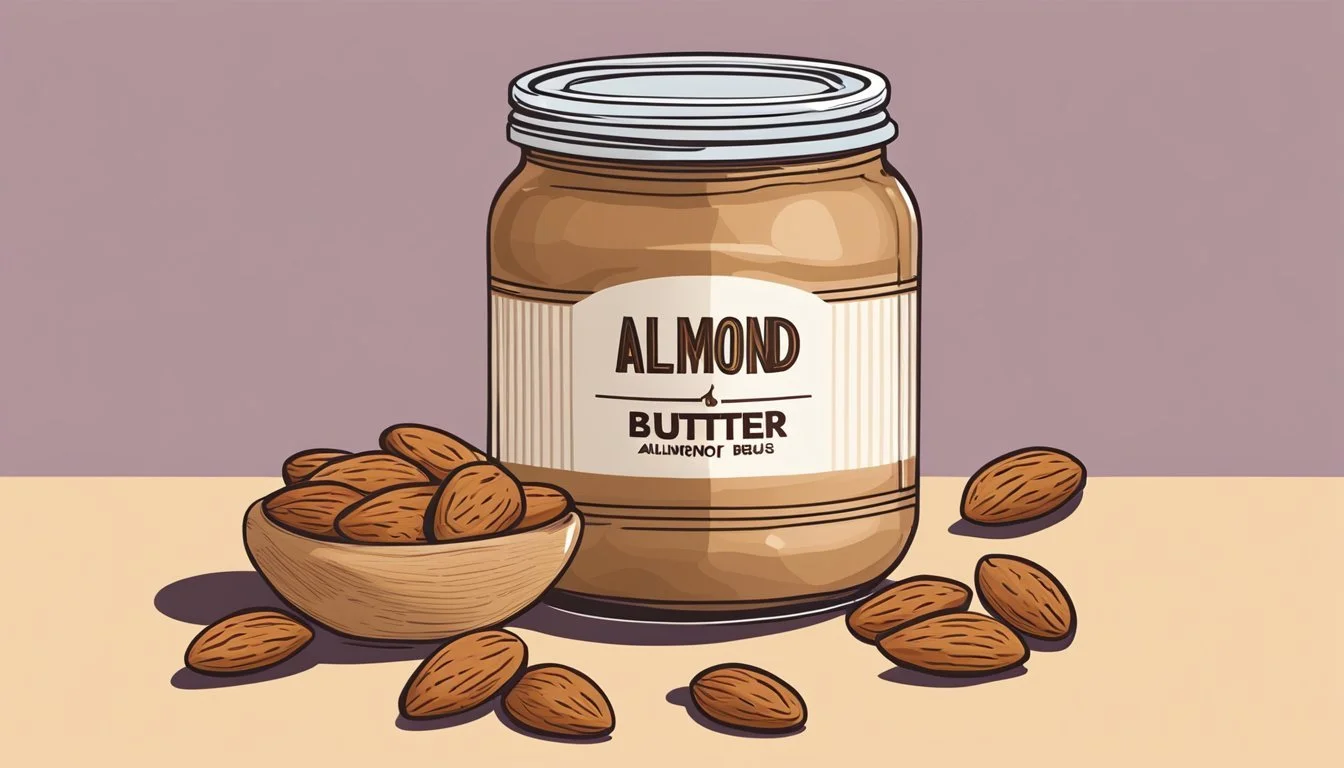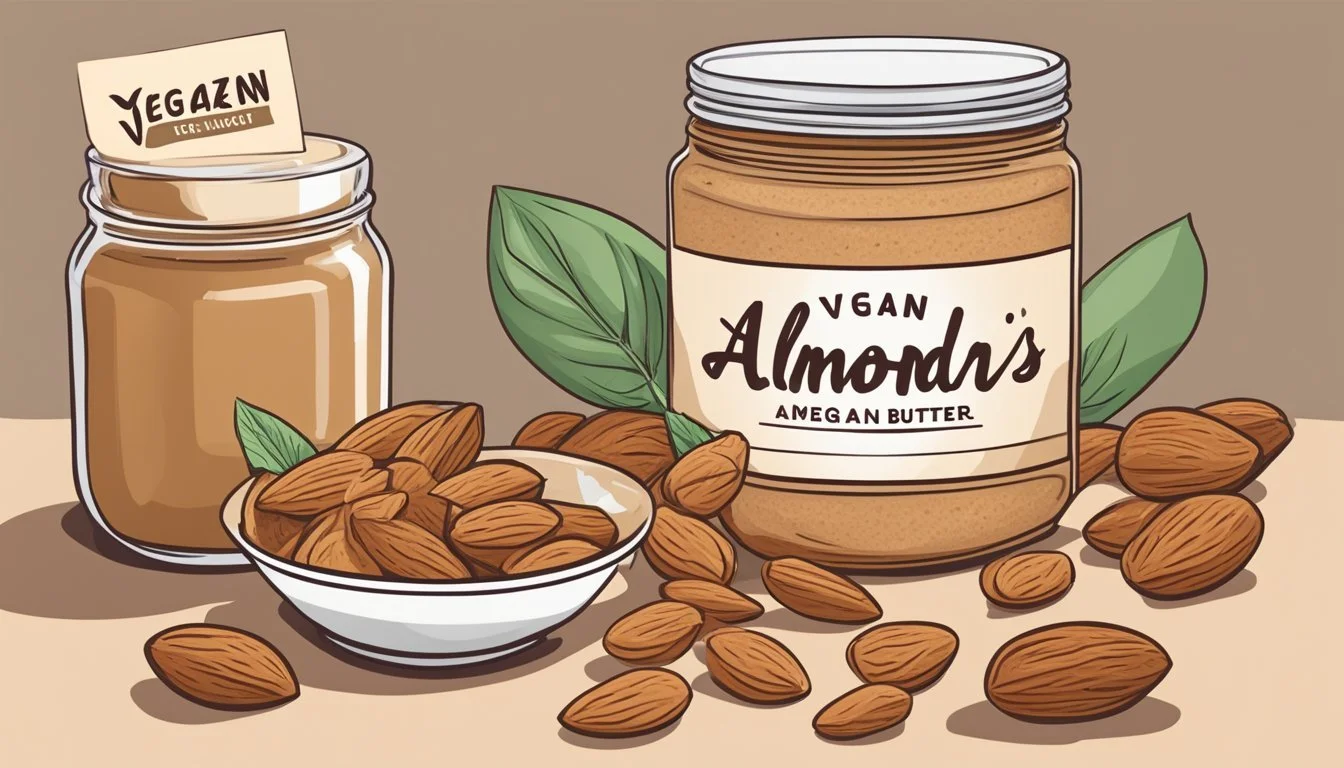Is Almond Butter Vegan?
Unveiling the Truth About This Popular Spread
Almond butter typically qualifies as a vegan product, made by grinding almonds into a smooth or crunchy spread. As a plant-based source of fat and protein, almond butter is a staple in many vegan diets, favored for its nutritional profile which includes healthy unsaturated fats, fiber, vitamins, and minerals. Vegans, who abstain from consuming all animal products, can generally include almond butter in their meals, as long as it's made with purely plant-derived ingredients.
However, consumers should be aware that not all almond butter brands are created equal when it comes to maintaining vegan standards. Some commercial almond butters may include additional ingredients like palm oil, sugar, and salt. The inclusion of palm oil, in particular, can be contentious within the vegan community due to environmental concerns associated with its production, such as deforestation and habitat destruction, which can harm wildlife. Therefore, individuals seeking vegan almond butter should check product labels for the inclusion of such ingredients and ideally opt for brands that avoid additives altogether.
In its purest form, almond butter should contain nothing but almonds. Those seeking a completely vegan option should look for brands that commit to simplicity and sustainability, which are values highly regarded in the vegan community. Homemade almond butter provides a straightforward alternative, ensuring that the end product aligns with vegan principles by controlling the ingredients used.
Understanding Almond Butter
Almond butter provides a plant-based source of nutrients and a vegan-friendly option in the world of spreads. It stands out among its nut butter counterparts for its ingredients and health benefits.
Definition and Overview
Almond butter is a spread made from either raw or roasted almonds. The basic process involves grinding the almonds into a paste, which can be smooth or chunky based on the duration of the grinding process. Almond butter may contain added salt, sweeteners, or oils, but the simplest form is just almonds—and this pure form is inherently vegan. It is important, however, to check labels for non-vegan additives that manufacturers may include.
Almond Butter vs. Other Nut Butters
Almond butter is often compared to other nut butters, like peanut butter and cashew butter, as well as seed butters such as sunflower seed butter. Here are some specific distinctions:
Ingredients: While peanut butter and almond butter might be similar in texture and usage, almond butter typically has a higher content of monounsaturated fats and may be preferred for its slightly sweeter taste compared to the more robust, earthy flavor of peanut butter.
Nutritional Profile: Almond butter generally offers more vitamins, minerals, and fiber than peanut butter. It is rich in Vitamin E, magnesium, and potassium.
Vegan-Friendliness: Like almond butter, most nut and seed butters are naturally vegan, although it's essential to read ingredient labels for any non-vegan additives.
Butter Type Key Ingredients Vegan-Friendly Notes Almond Butter Almonds Yes Check for additives. Peanut Butter Peanuts Typically Yes Sometimes contains added oils and sugar. Cashew Butter Cashews Yes Tends to be creamier. Sunflower Seed Butter Sunflower Seeds Usually Yes A good alternative for those with nut allergies.
In summary, almond butter stands out for its simplicity, nutritional value, and suitability for a vegan diet.
Health and Nutrition
Almond butter is a nutritious plant-based food that is rich in heart-healthy fats, vitamins, and minerals. It contains protein, fiber, and essential nutrients such as vitamin E, calcium, iron, magnesium, and potassium, contributing to a balanced diet.
Nutritional Benefits
Almond butter is a dense source of healthy fats, primarily unsaturated fats, which are beneficial for heart health. In terms of vitamins and minerals, a serving of almond butter offers about 26% of the daily recommended intake of vitamin E. Additionally, almond butter provides a good amount of magnesium, which is essential for over 300 biochemical reactions in the body. It also supplies protein, fiber, calcium, and iron, making it a well-rounded addition to a healthy diet.
Comparing Health Aspects with Other Butters
When compared to other nut and seed butters like peanut butter, cashew butter, and sunflower seed butter, almond butter generally offers similar beneficial nutrients such as healthy fats and fiber. However, almond butter stands out for its higher content of vitamin E and magnesium. Each butter has its unique nutritional profile, but almond butter is often chosen for its vitamin and mineral content.
Heart Health and Plant-Based Diets
Almond butter supports heart health due to its high unsaturated fat content. These fats help maintain healthy cholesterol levels, reducing the risk of heart disease. As part of a plant-based diet, almond butter can be a valuable food for maintaining cardiovascular health while providing the body with necessary nutrients without the need for animal products.
Dietary Considerations
When exploring the dietary considerations of almond butter, it is important to focus on its vegan-friendly status and compatibility with other dietary restrictions. Almond butter generally serves as a nutritious option that aligns with several dietary practices.
Vegan-Friendly Status
Almond butter is considered vegan because it is made primarily from almonds, which are plant-based ingredients. Most almond butter is free from animal derivatives, satisfying the key conditions of a vegan diet. Consumers should, however, be vigilant about product labels, as some brands might include non-vegan additives such as honey.
Other Dietary Restrictions
Aside from being vegan, almond butter suits various other diets. It is inherently dairy-free, aligning with lactose intolerance and dairy aversions. Moreover, almond butter typically fits into a paleo dietary framework, as it derives from nuts, which are permissible within paleo guidelines. The table below outlines the suitability of almond butter for different diet types:
Diet Type Suitability of Almond Butter Vegan Suitable (check for additives) Dairy-Free Suitable Paleo Suitable
Consumers with specific dietary restrictions should always check the ingredient list for the presence of additional components that may not align with their dietary needs.
Making Almond Butter
Almond butter is a versatile and healthy spread that is both vegan and easy to make at home with the right ingredients and equipment. The process primarily involves toasting, blending, and optionally flavoring almonds to create a smooth or crunchy butter to your preference.
Required Ingredients and Equipment
Ingredients:
Almonds: 2 cups (raw or roasted, unsalted preferred)
Salt: a pinch (optional, to taste)
Oil: 1-2 tablespoons (optional, for creamier consistency)
Equipment:
Oven or toaster oven (for roasting, if desired)
Food processor or high-speed blender (e.g., Vitamix, Cuisinart)
Spatula (for scraping down the sides)
Step-by-Step Process
Toasting (Optional):
Preheat the oven to 350°F (175°C).
Spread the almonds on a baking tray and roast for 10-12 minutes until they are just warm and smell nutty, shaking the tray halfway through.
Processing:
Place the almonds in the food processor or blender.
Process continuously for about 10-20 minutes, depending on the device’s power.
Periodically stop to scrape down the sides of the container.
Adding Ingredients (If Required):
Once the almonds begin to form a paste, add a pinch of salt if desired.
If needed, slowly drizzle in oil to reach a creamier texture.
Completion:
Continue processing until the almond butter reaches the desired consistency—smooth or slightly crunchy.
Homemade Almond Butter Variations
For sweet almond butter:
Add sweeteners such as 1-2 tablespoons of maple syrup or honey during the final minutes of processing.
For flavored almond butter:
Incorporate spices or flavorings like cinnamon by mixing them into the finished almond butter.
Almond Butter in Cooking and Meals
Almond butter's creamy texture and rich flavor make it a versatile ingredient in both sweet and savory dishes. It integrates well into recipes, enhancing them with a touch of deliciousness.
Recipe Integration
Incorporating almond butter into recipes is straightforward due to its spreadable consistency. It serves as a perfect base in smoothie bowls, adding a nutritious, creamy element to the breakfast favorite. Toast lovers can benefit from its richness by simply spreading it over their morning slices - a boost of energy and flavor for the start of the day. For baking, almond butter can replace traditional fats to provide a healthier, yet equally decadent, quality to desserts.
Breakfast Recipes:
Smoothie bowls
Almond butter toast
Baking:
Brownies
Snacks:
Energy bars
Creating Sweet and Savory Dishes
Almond butter excels in both sweet and savory applications. Sweet dishes like desserts often revel in its creamy nature, playing a starring role in creating luscious fillings and toppings. In savory dishes, almond butter adds a nutty depth to sauces and dressings, such as an almond-lime dressing that is perfect for invigorating a crunchy salad. The butter's versatility extends to snacks, where it can be a key ingredient in homemade energy bars or a dip for fruits and vegetables.
Desserts:
Cake frosting
Chocolate almond truffles (What wine goes well with truffles?)
Savory Dishes:
Almond-lime dressing for salads
Spread in sandwiches and wraps
Storage and Preservation
Proper storage and preservation are essential to maintain the quality and extend the shelf life of almond butter. Almond butter, a vegan spread, is not only easy to make but also requires careful storage to keep it fresh and edible.
Optimal Storage Conditions
For optimal storage, almond butter should be kept in a cool, dark place with stable temperature conditions. It thrives best when stored in a refrigerator, where it can retain its freshness for a longer period. Airtight containers or glass jars are best suited for storage to prevent exposure to moisture and air, which can spoil the butter.
Key points for storage:
Refrigerate the almond butter.
Use an airtight container or glass jar.
Keep in a consistent, cool environment.
Shelf Life and Freshness
The shelf life of almond butter can vary depending on whether it is store-bought or homemade. Generally, store-bought almond butter that's unopened can last several months up to its expiration date. However, once opened, it should be consumed within one to two months for the best quality. Homemade almond butter has a shorter shelf life, typically lasting two to three weeks when stored correctly in the refrigerator.
To maintain freshness, one should ensure:
Regularly check for signs of spoilage such as mold or an off smell.
Keep the container tightly sealed after each use.
Remember, consistent storage practices will help keep almond butter in its best state for as long as possible.
Alternatives and Substitutes
When looking for a substitute for almond butter, whether due to allergies, personal taste, or availability, there are numerous options one can consider. These alternatives come in various forms, from other nut and seed butters to different blends that can be commercial or homemade.
Non-Almond Nut and Seed Butters
Peanut Butter: A classic and widely available substitute, peanut butter shares a similar texture and protein content with almond butter. However, it has a distinct taste that can influence the flavor profile of dishes.
Cashew Butter: Cashew butter provides a creamy texture and is sweet with a less pronounced flavor, which makes it a versatile alternative in recipes that call for almond butter.
Sunflower Seed Butter: For those with nut allergies, sunflower seed butter acts as a safe and nutritious replacement, boasting a smooth consistency and a mild taste.
Pumpkin Seed Butter: High in magnesium and vitamin E, pumpkin seed butter is a robust choice that offers less sugar content compared to almond butter.
Tahini (Sesame Seed Butter): Tahini has a more savory flavor profile and can be used in dressings and sauces, offering a twist on traditional nut spreads.
Nutella is not an ideal substitute for those seeking a vegan option or health-conscious choice due to its added sugar and dairy components.
Commercial vs. Homemade Blends
Commercial Nut and Seed Butters: They are convenient and come in various flavors and textures. While they offer uniformity and consistency, checking labels is crucial for vegan consumers to avoid added non-vegan ingredients.
Homemade Nut Butters: Homemade blends allow for full control over ingredients and can be tailored to personal taste. For vegans or those with dietary restrictions, creating nut butter at home ensures that the end product aligns with their values and health requirements.
Making homemade nut butters typically involves processing nuts or seeds until they reach the desired consistency. It may also be more cost-effective and eliminates the preservatives found in some commercial brands.
Environmental and Ethical Considerations
When examining whether almond butter is vegan, both the environmental and ethical dimensions of its production must be considered. The focus is not only on the plant-based nature of almonds but also on the sourcing, manufacturing processes, and choices consumers have for sustainable and ethical consumption.
Sourcing and Production Impact
Almond butter production involves several environmental considerations. Almonds require significant water resources for cultivation—a point of concern in areas facing water scarcity. For every pound of almonds produced, an estimated 1,900 gallons of water is used. The environmental degradation associated with almond farming can include the depletion of local water resources and potential impacts to ecosystems.
Almond Milk, Almond Meal, Almond Flour: These almond byproducts share similar concerns as they stem from the same source crop.
Roasted Nuts: The process of roasting may add energy consumption to the overall environmental footprint.
Additionally, transportation of almonds, especially when sourced from a distance, contributes to greenhouse gas emissions. This is particularly impactful when almonds are bought in bulk, increasing cargo weight and the energy required for logistics.
Sustainable and Ethical Choices
Consumers seeking to make sustainable and ethical choices regarding almond butter can look for products that prioritize environmentally friendly practices. Key factors include:
Water Conservation: Brands that implement water-saving techniques in their almond cultivation practices.
Organic Farming: Utilization of organic farming methods that eschew harmful pesticides and chemicals.
Ethical Sourcing: Emphasis on fair labor practices and sourcing from farms that do not cause significant ecological damage.
By choosing almond butters that align with these standards, one can support sustainability while enjoying a plant-based food. Additionally, checking product labels for certifications can provide assurance regarding ethical practices, such as the avoidance of additives like honey, which is of concern to some vegans due to bee welfare issues.
Consumer Insights
When exploring almond butter options, consumers often consider factors such as taste, texture, and quality. Brands vary significantly in these areas, and user reviews can offer valuable insights into the overall satisfaction of the product.
Brand Comparisons and Reviews
Taste and Texture: The flavor profile of almond butter can range from sweet and creamy to more robust and earthy. Texture is another critical aspect, with some brands offering a smooth consistency while others provide a chunkier experience. Consumer feedback often emphasizes the importance of these sensory characteristics in their brand preferences.
Smooth Almond Butter Brands:
Brand A: Received high ratings for its creamy texture, with a subtle sweetness that enhances the almond flavor.
Brand B: Consumers note a slightly saltier taste, ideal for those who prefer a savory hint in their spread.
Chunky Almond Butter Brands:
Brand C: Offers a coarser texture that consumers enjoy for its crunchy almond pieces, providing a satisfying bite.
Brand D: Feedback suggests a drier texture but a rich almond taste, appealing to those who favor a more intense nut flavor.
Quality and Rating: Quality is often assessed by ingredient purity and the brand's processing methods. Organic, non-GMO, and minimally processed almond butters typically receive higher quality ratings from consumers.
Tips for Selecting Quality Almond Butter
When selecting an almond butter, customers should examine the following:
Ingredients: Look for almond butter with the fewest ingredients. The primary component should be almonds; avoid products with added sugars or palm oil, unless preferred for personal taste or texture reasons.
Certifications: Check for certifications like USDA Organic or Non-GMO Project Verified, as these can be indicators of quality.
Brand Reputation: Research the manufacturer’s reputation for quality. Established brands with positive consumer feedback are often reliable choices.
Remember, the best almond butter for an individual is one that balances taste, texture, quality, and personal dietary preferences in a way that satisfies them.
Customizing Almond Butter Experience
Creating almond butter at home allows individuals to design a spread that aligns precisely with their taste and texture preferences. One has the freedom to achieve a creamy texture or a smooth paste, and introduce variations to satisfy their palate.
Adding Personal Touches
To individualize almond butter, one might consider the inclusion of various ingredients to enhance flavor. Sweeteners like honey or maple syrup can be added for a touch of sweetness, while a pinch of salt may enhance the almond's natural flavors. Spices such as cinnamon or vanilla extract also present opportunities to diversify the taste profile. These personal touches not only create a customized flavor but can also adjust the texture from creamy to crunchy based on preference.
DIY Almond Butter Techniques
Homemade almond butter is simple and cost-effective. Here are the basic steps to create a basic smooth paste:
Roast almonds in an oven for about 10 minutes to intensify their flavor.
Allow them to cool slightly, then transfer to a food processor.
Process until the almonds break down into a buttery consistency, typically between 15 to 25 minutes depending on the processor's power. Frequently scrape down the sides to ensure an even consistency.
For those seeking a creamier texture, one may need to process the almonds for a longer period. Adding a small amount of oil can help achieve this creamy result. Additionally, the technique can be customized further by experimenting with the degree of roasting, or by blending different nut varieties to create a unique almond-based spread. Homemade almond butter is not only easy to make but also allows one to enjoy a fresh, preservative-free product tailored to their own tastes.











